Weeds
Weeds and weeding are the central focus of the groups strategy to regenerate the bush on Cooleman Ridge.
But weeds are often misunderstood by the general public, who can either confuse weeds with natives or simply believe that everything is a weed.
This page is intended to give a general overview of the definition, history, distribution and types of weeds found on Cooleman Ridge.
Definition
The definition of what is and what is not a weed is somewhat contentious. However, a basic definition of what constitutes a weed for the group is basically "any plant that was not present prior to european settlement". This definition is itself somewhat contentious as it may not always be clear what was present prior to European settlement, but it is reasonable criterion.
The problem of what constitutes a weed is also complicated by several other factors including:
- Context - a weed in one context may not be in another context. For example, weeds can have different meanings in either an agricultural or an environmental context. The group uses a more environmental interpretation of what a weed is.
- Location - the location of a plant can be significant because a native in one place can be a weed in another. For example, something that is native in one state, region or locality may be a weed in another. Even a matter of metres can make a difference as to whether a plant is considered a weed or not.
- Names - the common (as opposed to the scientific) names for plants can be very misleading as they can sometimes have the word "weed" included in them because that reflected the perspective of the the person giving the plant its common name (eg. a farmer may consider it to be a weed, but not an ecologist). However, this does not necessarily mean that it is an environmental weed. Conversely, there are many environmental weeds that do not have the word weed in their name.
- Appearance - the appearance of a plant can be deceptive. Many people have preconceived ideas about what a weed looks like and what a native looks like. However, many plants that look like weeds are not, and vice versa.
The best way to determine what species is a weed and what species is not a weed according to the group is to consult our Plant Survey. This survey clearly identifies the status of the plant as either a Native or a Non Native (ie. weed)
History
The history of weeds closely follows the history of the ridge itself. The most significant factor in the history of the ridge that has influenced the history of weeds on the ridge has been the presence of grazing on the ridge. Grazing occurred on the ridge for over 100 years before the Cooleman Ridge Nature Reserve was created in the 1980s.
Grazing has been significant because it has "damaged" many areas by doing the following:
- Pasture grass was deliberately introduced (eg. phalaris, fescue, ryegrass)
- Fertilisation (ie super phosphate) was introduced which generally favours weeds over natives.
- Clearing of native tree cover both reduced native cover as well as provided extra space for weeds.
- Large herbivores were introduced which decreased native cover because native grass have not evolved to cope with their grazing pressure.
- Overgrazing (eg. in times of drought) exposes the soil and makes the area vulnerable to invasive weeds.
- Animals and vehicles carried the seeds of weeds and thus spread new weeds into the reserve.
- Roads and tracks were introduced exposing the soil and provide a pathway for weeds.
Distribution
The distribution of weeds on the ridge strongly correlates with the distribution of former grazing on the ridge - most weeds are generally found in areas of the ridge that have been "damaged" by grazing.
There were large parts of the ridge that were not intensively grazed and thus still have most of their original native cover. These areas were the ones considered not suitable for grazing such as steep, rocky or heavily wooded areas. These where typically on the hills of the ridge.
Conversely there are large parts of the ridge that were intensively grazed and consequently now have large weed infestations. These areas were the ones that were flat, deep soiled and thinly wooded. These are typically the areas in the saddles between the main hills on the ridge.
The ratio of "good" to "bad" areas on the ridge is now roughly half and half. There is a broad spectrum of areas on the ridge from very good to the very bad and everything in between. However, even in some of the worst areas there often still remains a significant element of original cover even if that area is dominated by weeds.
The north east face of the ridge (ie. the Chapman side) has mostly good native cover with only a few major infestations of weeds. Conversely, the south-west facing side of the ridge has major infestations of weeds.
Types
There are large number of different types of weeds on the ridge. They cover a wide range of sizes, forms and problems.
There are however only approximately a dozen weed species that constitute the main bulk of the weeds on the ridge. The following is a shortened list of the main weeds found on the ridge plus information about their identification, distribution and control. For a complete list of all weeds found on the Cooleman Ridge Nature Reserve, please see our Plant Survey.

Blackberry is a very large bush that has long canes, thorns and berries. It can grow to be very large and form dense thickets that provide habitat for other pests such as rabbits. Blackberry has many means of spreading including seeding and suckering and is highly invasive and will spread rapidly if not controlled.
Blackberry is a major problem on the ridge. It can be found on most parts of the ridge in varying degrees of severity. However, the main infestation of Blackberry is on the eastern face of Mt Arawang where over a hundred large bushes have been identified. The group tracks the position of every known blackberry bush as part of its Blackberry Survey to assist in its control.
Blackberry is difficult to control and requires an approach quite different to other major weeds on the ridge. It is only effectively treated with poisoning. The poison is normally applied by spraying the leaves of the plant. Blackberries are typically sprayed in late summer or autumn when they are actively growing and after fruiting. Large infestations require commercial grade equipment to treat, such as motor vehicles, pumps and long hoses. Small or juvenile bushes can be poisoned by using a hand held spray pack or by painting the leaves with a herbicide solution.
Poisoning of Blackberry is mainly performed by Parks and Conservation officers or their contractors rather than the group itself. The group assists the work performed by Parks and Conservation by communicating the location of bushes to Parks and Conservation workers/contractors. The group complements the work performed by ACT Parks and Conservation by controlling smaller infestations before they become to big for the group to control.
N.B. Blackberry is easily confused with the Native Rasberry because they look very similar and are from the same genus.
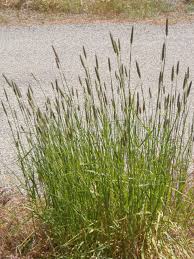
Canary Grass is a large, thick, perenial tussock grass. It grows well during the spring and dries out in the summer. In mass plantings, it forms thick mats that dominate all other plants. It is a pasture grass that was deliberately planted by former pastoralists to signficantly increase the amount of feed available for their grazing animals. It is a native of Southern Europe and has adapted to being grazed by large herbivores.
Canary Grass is also significant because it is a major fuel source for grass fires on the ridge. Eliminating Canary Grass is important part of minimising dangerous grass fires on the ridge. See our Fire page for more information.
This weed is widespread on the ridge. It is generally found on the lower and flatter parts of the ridge that were preferred areas for farmers to convert to pasture. The most significant examples are found on the south west facing slopes of the ridge such as between Lincoln Place and Arawang Homestead.
Canary Grass is not very invasive and can be controlled either by hacking or by poisoning. This require multiple treatments over several seasons. The group has made significant progress with removing Canary Grass from most of the Group Areas but large patches still remain elsewhere on the ridge.
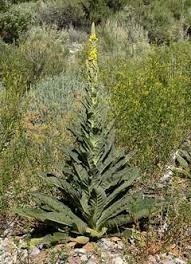
Aaron's Rod is a large herbasceous plant with a large rosette and large vertical stem. It typically germinates in the autumn after rain and grows relatively slowly through the winter and spring. It is a garden escapee.
Aaron's Rod is very common in Canberra nature parks and is widely dispersed throughout the ridge. The best examples found are in the Kathner Street group area. It is easily identified and is normally the first weed newcomers weed.
Aaron's Rod is easy to control and responds well to hacking, beheading or poisoning. The group has been able to largely eliminate this weed in each of the group areas.

Wild Sage is a herbaceous weed that is closely related to culniary sage. It germinates in the winter and and grows during the spring. It generally has a large rosette with a tall stem with purple flowers. It is
Wild Sage is fairly widespread on the ridge. It occurs in areas that have been damaged. The best example of significant infestations are at Group Area Darrell Place and Group Area Lincoln Place.
Wild Sage is quite easy to control and responds well to hacking or poisoning. The group has been able to largely eliminate this weed in each of the group areas but significant infestations still exist elsewhere on the ridge.
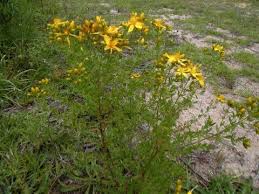
St Johns Wort is highly invasive noxious weed. It germinates in the late winter and seeds in the spring. St Johns Wort is significant because it is one of the few weeds that will invade non damaged errors.
St Johns Wort is a major problem on the ridge. Its presence has increased significantly in recent years and the ridge now has large infestations of it. It is most common on the wetter and cooler south western slopes of the ridge above the various horse paddocks.
Most techniques of weed control such as hacking or poisoning are ineffective against St Johns Wort. This is partly due to the fact that St Johns Wort does not have a distinctive rosette to either hack out or poison. It is also has an extensive root system and will reshoot if all the roots are not removed. The main control method for St Johns Wort that is available is a biological control with the presence of the St Johns Wort beetle.
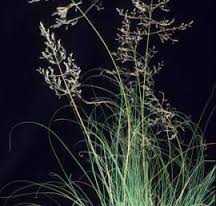
African Lovegrass is a small grass that grows on bads soils. It is blueish grey when growing and becomes golden brown as it dries out during the warmer months. It is a prolific seeder and a highly invasive weed that will colonise damaged areas quickly and forms monocultures that crowd all ofther natives out. It is also spread by grass mowing.
The ridge has some significant patches of African Lovegrass. The most signficant example is found around the large reservoir above Darrell Place. It is also often found along fire management tracks where mowing is more frequent.
African Lovegrass is reasonably easy to control and can be hacked out or poisoned. Small local localised infestations of lovegrass are regularly controlled by the group to prevent further spreading but large uncontrolled patches remain. It has been largely controlled in the Group Areas but remains a major problem outside of them.
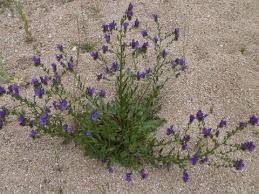
Patterson's Curse is a small to medium sized herbaceous weed. It has bright green leaves with purple flowers and is very fast growing. It prefers areas that have deep wet soils. It germinates in wet periods at any time of the year, rapidly flowers and seeds, before quickly dying off in dry periods. It is an opportunistic grower and can occur during any season. It is a highly prolific seeder and infestations can be extremely dense. It is highly invasive of disturbed ground by does not compete well with good quality native cover.
The ridge has had large infestations of Paterson's Curse in the past especially on the western end of the ridge. The most signficant example is found around the Kathner Street Dam.
Patterson's Curse is reasonably easy to control and can be hacked out or poisoned. It is critical that Pattersons curse is replaced with native cover quickly or else repeat infestations will easily occur.
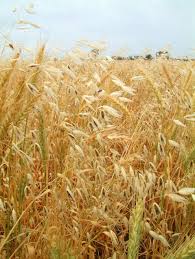
Bearded Oats is a tall, slender and rapidly growing grass. It is annual that germinates in late winter and rapidly grows to maturity within a few weeks. It dries out rapidly in late spring and early summer and becomes a golden colour. It remains standing until the autumn.
This weed is common throughout the ridge and is typically found in damaged areas that have been heavily grazed (ie. pastured areas). It is most common on the western ends of the ridge around Kathner Street and Chauvel Circuit.
Bearded Oats is also significant because it is major fuel source and can rapidly increase the speed and intensity of grass fires. Eliminating Bearded Oats is an important part of the groups strategy to minimise dangerous grassfires on the ridge. See our Fire page for more information.
Wild Oats is difficult to directly control because both of its speed of growth and the fact that it does not have a rosette that allows it to be easily hacked or sprayed. However it does not compete very well with native grass areas and can easily be indirectly controlled by replacing infested areas with native grasses, which will quickly out competed.
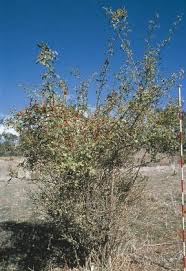
Sweet Briar is a large bush that resembles a common garden variety rose bush. It has a woody stem, thorns and red/orange berrys on it that are easily spread by birds.
Sweet Briar Rose is the most significant woody weed on the reserve. It is widely dispersed over the ridge. The group tracks the position of every known bush as part of its Wood Weed Survey.
Sweet Briar Rose is best treated by poisoining using a cut-and-dab method. The group spent a significant amount of time poisoning it in its early years. The group has now largely eliminated this weed from the ridge but pockets still remain.
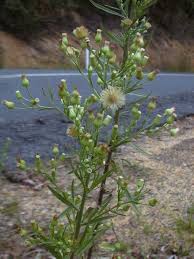
Fleabane is a large slender herbaceous weed. It germinates into a small rosette in the winter and grows rapidly to approximately 1m in height. It grows in large and dense thickets.
Fleabane is common in the lower grazed (ie damaged) areas of the ridge. Infestations are sporadic with explosions of fleabane most common in wet seasons.
Fleabane is reasonably easy to control and can be beheaded, hacked or poisoned. Fleabane is not currently a major problem on the ridge but future infestations are likely.
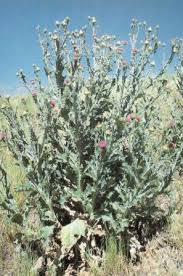
Scotch Thistle is a large greeny-grey herbaceous plant. It germinates in the autumn or winter after rain to form are large rosette. It then grows rapidly in the spring to to form a large stalk with prickles and multiple seed heads. It is a prolific seeder and and an aggressive coloniser of damaged areas.
Scotch Thistle has been a major problem on the ridge. This was especially the case on the summit Mt Arawang. However, it can easily be controlled with either hacking or poisoning and will not reappear once native cover has been restored. The group has largely eliminated this weed from the ridge.

Plaintain is a small, perennial, herbaceous weed. It germinates in winter and grows quickly in the spring. It is fast growing and can reproduce quickly. It grows in high densities with many 10s per square metre. It grows well in damaged areas it is a common weed of former pasture lands.
Plantain has been a major problem on the ridge and is widely dispersed. It occurs in damaged areas and can occur in high densities.
Plantain is best controlled with hacking. The group has been successfully in largely controlling Plantain in the group areas but large infestations are still common elsewhere on there ridge.